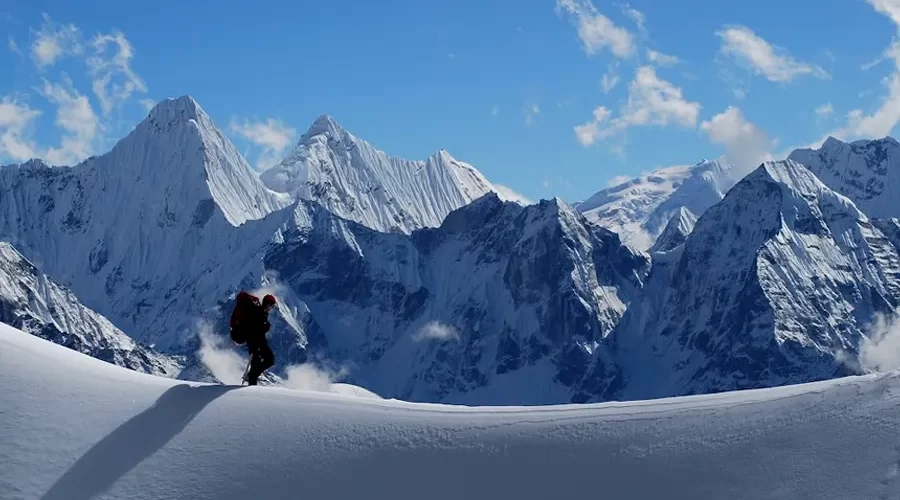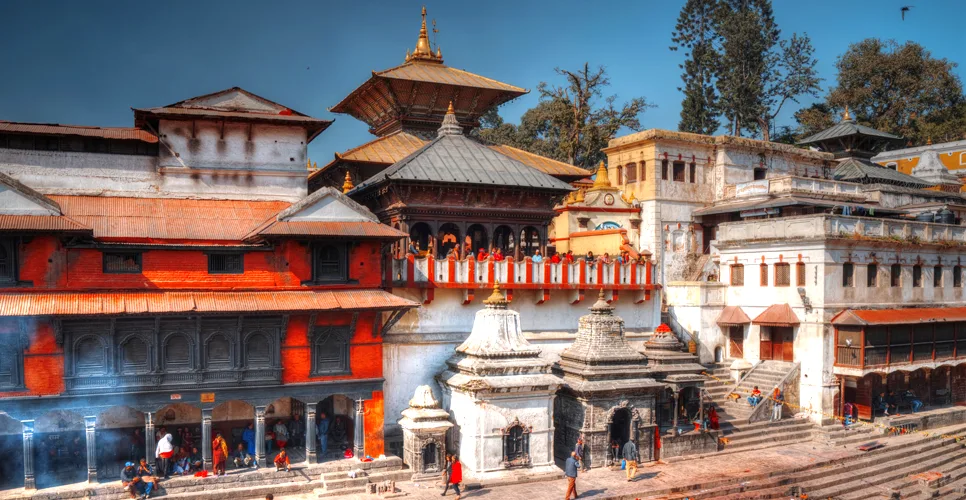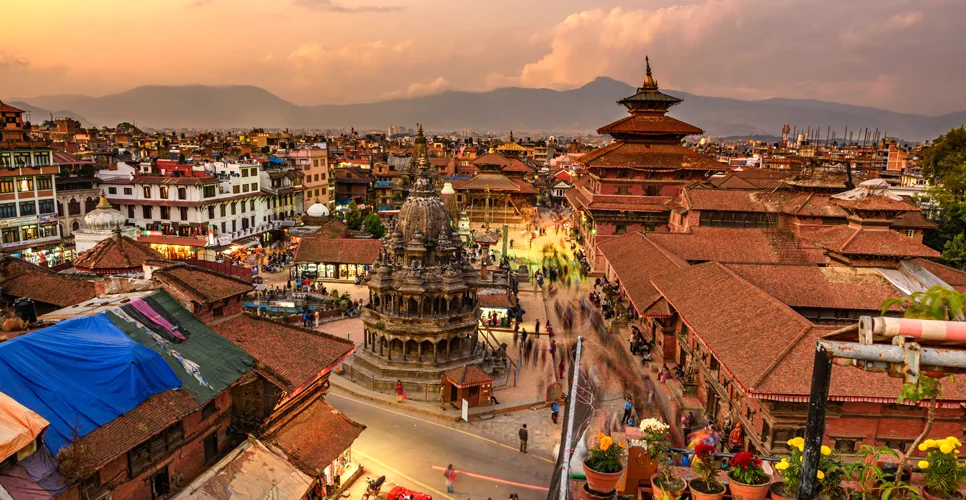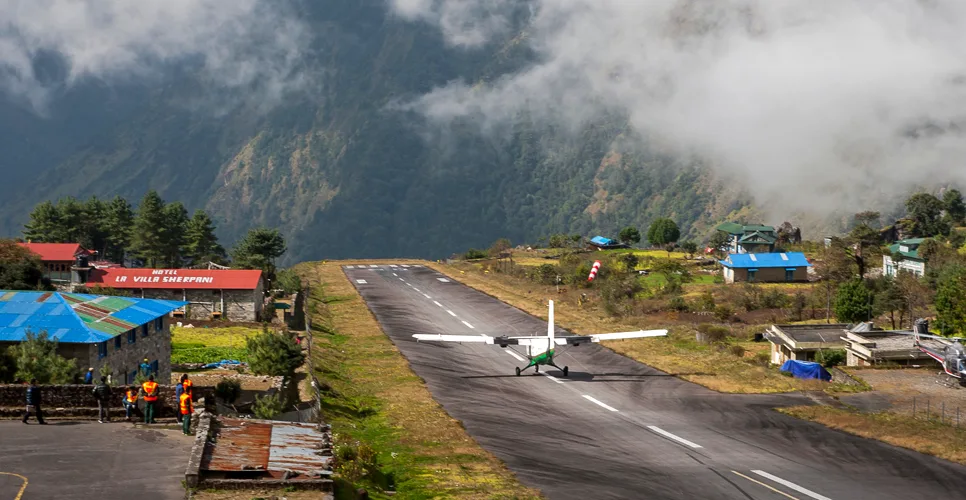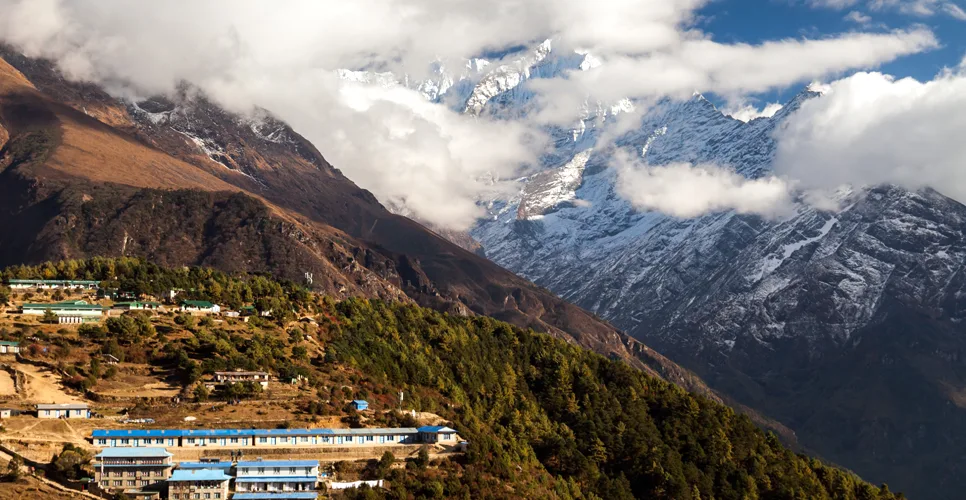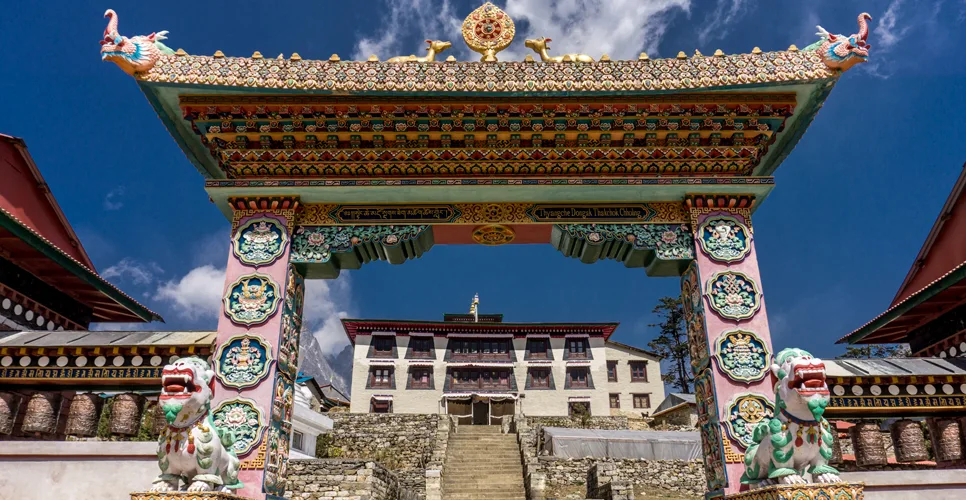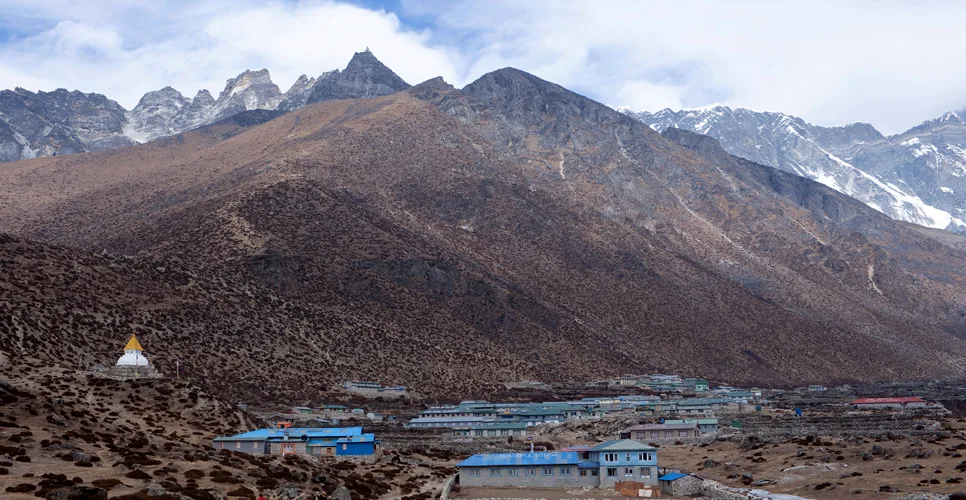Overview of Lobuche Peak Climbing
Lobuche Peak climbing offers a thrilling journey in Nepal’s renowned Khumbu region. While it’s a favored destination for trekkers, one must be physically fit and mentally prepared for the ascent.
The Lobuche Peak climbing journey goes through diverse landscapes, lush forests, and rocky terrain. The trip offers stunning views of high mountains like Everest, Lhotse, Nuptse, and many more mountains of the Everest region. You’ll also experience the Sherpa culture, monasteries, local shops, and Nepalese foods.
Lobuche Peak is located bordering Mount Everest and is an impressive 6,119 meters (approximately 20,075 feet) above sea level. It is a spectacular mountain famous for its remarkable beauty and challenging ascent.
Lobuche Peak is not a single mountain as it has two different parts called Lobuche East and West. Both climbing options provide climbers with unique challenges and rewards. The Lobuche Peak climbing trip is highly preferred by adventurous people passionate about the Himalayas Adventure.
The trip presents an exceptional opportunity to enhance your mountain climbing skills. The adventure explicitly allows you to acquire proficiency in ice and rock handling techniques.
How our Lobuche Peak climbing journey begins
The Lobuche Peak Climbing adventure begins with the renowned Everest Base Camp Trekking. This incredible journey takes you through stunning forests, charming Sherpa villages, and ancient monasteries, offering breathtaking views of the Khumbu area at every turn.
After reaching Everest Base Camp and the renowned Kala Patthar, we return to Lobuche village, the starting point for the Lobuche Peak Climbing.
As we approach the Lobuche Base Camp, at an elevation of 4950 meters, the path leading up the valley from Lobuche progressively transforms. It becomes steeper and more challenging with each step.
As we approach the Lobuche Base Camp at an altitude of 4950m, the trail up the valley from Lobuche gradually becomes steeper and more rugged.
From the Base Camp, we ascend steep stone terraces and snowy slopes. We employ fixed ropes to make our way up the ridge along the southwest face. At an elevation of 5600m, we will establish a High Camp.
Preparation for Lobuche Peak Climbing
If you are planning to join or are considering joining a Lobuche Peak climbing, it is important to start focusing on your training now. Lobuche Peak should not be considered a mere trekking peak, as it demands much respect and caution.
Having prior technical climbing experience and being mentally fit are important factors for a successful ascent to the peak. You must prioritize your physical fitness and overall health, which helps you enjoy your Lobuche peak climbing experience. You will need to climb for approximately 8-10 hours per day.
Below, we have listed some preparation tips for the Lobuche peak climbing that can help you maintain physical and mental fitness:
- Create a training plan that’s designed specifically for your upcoming trip.
- Understand fixed-line climbing techniques thoroughly to ensure safety at high altitudes on the glacier.
- Make sure to train for at least five days every week, dedicating an hour or more to each training session.
- Emphasize high-volume, low-intensity training for effective preparation.
- It is recommended to continue with your exercise routine after completing a month of initial training. During this period, dedicate 1 hour in the gym and engage in 3-hour hikes.
- Include a well-rounded weight training program that covers core, lower body, and upper body exercises.
- To navigate smoothly between rocks on a steep incline of 60 to 70 degrees, it is essential to have efficient movement skills.
- It is important to feel at ease when engaging in open conversations with your guides.
- To make your trip successful, express support and respect for your fellow teammates.
- Maintain a humble, respectful, and considerate attitude when facing pressure during the climb.
Trip Difficulty of Lobuche Peak Climbing
Lobuche Peak climbing in Nepal is considered to be one of the most challenging peaks to climb in the Everest region of Nepal. We ascend to heights above 5000 meters, a significantly elevated altitude where no form of life can survive. Although this peak is not particularly technical, it reaches an altitude of over 5000 meters. It is an extremely high elevation where survival is nearly impossible.
The temperature is low, and the weather is quite unpredictable. The thinness of the air presents a challenge for our ascent. Properly acclimatizing your body before reaching the summit is important.
Although Lobuche Peak climbing is known for its challenging nature, a successful ascent can be achieved through consistent practice, proper acclimatization, strong physical stamina, and a determined mindset. Climbing through a challenging and rugged topographical terrain is necessary.
Therefore, it is crucial to prepare for climbing adequately. In order to acclimate to Lobuche Peak, we plan to walk from Lukla to Phakding and then gradually ascend. The next day, we proceed to Lobuche Base Camp and began our ascent to the peak. Prior to ascending the Lobuche West Peak, our team will receive crucial mountaineering preparation from our experienced Sherpa guide.
Recommended Best Seasons for Lobuche Peak Climbing
The best seasons for Lobuche Peak Climbing in Nepal are spring and autumn. During these times, the weather is typically balanced and stable, offering clear skies. However, Nepal’s topography and climate are quite complex, which adds further depth to the topic.
Lobuche Peak attracts a growing number of tourists during both winter and summer seasons and for a meaningful purpose. Nepal is a fantastic year-round destination when you have the right knowledge, travel plan, and preparation.
Spring and autumn are the two main trekking seasons in Nepal. Spring is particularly popular due to its stable weather, which provides the perfect environment for classic treks in Nepal that involve high pass crossings.
One disadvantage of spring is that the skies can occasionally become hazy, which may block the beautiful mountain views. You are going to meet tourists from all around the world because the trekking routes are frequently crowded. Some might consider this as a benefit, but others may see it as a disadvantage and prefer to have the natural surroundings all to themselves.
Another best hiking season in Nepal is considered as in autumn. An excellent chance to immerse oneself in Nepal’s rich cultural history is also provided there. There are numerous festivals available. Nature is adorned with vibrant colors as if everything has been freshly washed.
The vegetation flourishes greatly during the monsoon season. The exceptional conditions attract a large number of people from around the world, resulting in busy trails and crowded teahouses.
Food and Accommodation during the trip
If you are curious about accommodations and meals during Lobuche Peak Climbing in Nepal, we can provide tents and lodging options. Climbing can be enjoyed at well-maintained inns operated by local residents.
Every hotel has a main public area with a fireplace, but the bedrooms do not have heating facilities. Rooms are available with beds, mattresses, blankets, and pillows. The showers are typically powered by gas, and some still use the iconic ‘drop’ toilets, but most now have flush systems.
The meals provided during the Lobuche Peak Climbing are excellent, offering a delightful combination of local Nepali/Sherpa cuisine and Western dishes. There are also several cafes that offer a variety of drinks, snacks, sweets, and chocolate.
The most challenging task could be avoiding consuming junk food and following a simple diet. We will be sleeping in mountain tents, which are designed to accommodate humans like regular tents.
In addition to a high-quality sleeping mat, we use a four-season sleeping bag. To prevent overheating, consider using a sleeping bag liner when sleeping in an open-zipped four-season bag.
The porters are available to transport your essential baggage weighing up to 15 kg. You will have both a guide and a mountaineering sherpa accompanying you throughout the entire Lobuche peak climbing trip. Our experienced team ensures your safety and satisfaction in high altitudes.
Altitude Sickness
During this climbing trip, you will traverse various altitudes, beginning from Kathmandu and ultimately reaching the highest point at an elevation of 6119 meters. It suggests that you have a greater chance of developing symptoms of high altitude. To avoid altitude sickness, a good amount of rest and enough time for acclimatization is necessary.
You could have symptoms including nausea, vomiting, shortness of breath, insomnia, appetite loss, and other health problems. Physical fitness is important, and regular physical activity gives you important health and mental benefits during your thrilling Lobuche peak climbing journey.
To adequately prepare for your Lobuche Peak Climbing trip, it is crucial to engage in physical training for a period of three to four months. Using a weighted backpack can be beneficial for enhancing stamina and improving your ability to walk on hills effortlessly. If you have not engaged in any high-altitude trekking before, you may need to increase your training efforts.
To ensure a safe and successful ascent of Lobuche Peak, it is crucial that one maintain excellent health through proper breathing techniques, maintaining a low heart rate, staying well-hydrated, pacing oneself effectively, and having great stamina.
Additionally, you will develop excellent stamina, allowing you to navigate uphill and downhill terrain with ease while carrying a weighted backpack at high altitudes. We are here to provide you with guidance and support as you prepare for your Lobuche Peak climbing in Nepal. Our team will always be enthusiastic about helping you and ensuring that you are well-prepared for the climb.
Group and Private Climbing
We offer both group and private trips for Lobuche Peak Climbing in Nepal. If you have ever thought about planning a private or group vacation to Nepal, we are here to assist you. We have a specialization in providing private group tours and trekking experiences for travelers.
Our private trip is carefully planned to give you a unique, individual experience. Nepal has a lot of beautiful scenery, from mighty snow-capped mountains to lush woods. You can also learn about the country’s rich cultural history.
Our private trip for Lobuche peak climbing is more professional, whose only goal is to make your trip unforgettable. Our goal is to fulfill your expectations and make your trip everything you wanted it to be. This trip has everything carried out just the way you want it. In order for us to create a plan for you that reflects your ideas, please tell us what you want to include during the inquiry.
Personal Expenses during the trip
During trekking, phone communication depends on NTC and NCELL SIM cards. Users are required to purchase recharge cards in order to obtain credit. Although the cost of calls is reasonable, trekking packages do not include coverage for them. Guesthouses offer Wi-Fi access for an additional fee, ranging from NPR 100 to NPR 300. Tea houses typically require a fee for battery charging, which usually ranges from Rs. 100 to 350.
Hot showers in lower areas are provided free of charge, while gas showers in high-altitude regions can be quite expensive, ranging from NPR 150 to 450. This higher cost is primarily due to the transportation challenges associated with delivering gas to these remote locations.
If you require additional porter services beyond what is already provided, please note that there will be an additional charge for the extra support. Trekking also offers opportunities for voluntary donations to schools and monasteries. However, it’s important to note that these donations are not included in the overall expenses and must be covered as personal expenses.
Climbing route for Lobuche Peak
The Lobuche Peak Climbing adventure in Nepal begins in Kathmandu, where you will take a short 35-minute flight to Lukla. We will journey from Phakding to Namche Bazaar, passing through a series of charming settlements, such as Tengboche and Pheriche, before reaching our destination of Lobuche. Along the way, we will encounter a variety of lodges and hotels that offer comfortable accommodations.
The route from the high camp becomes slushier as we continue. We will need to cross the rocky slab using the roper. The route then passes through a narrow, icy ridge, which is considered a technically challenging section of this expedition.
As we reach the Lobuche summit, we are greeted by the sight of fluttering flags. Our journey continues as we make our way back to Lukla, and finally, we conclude our peaceful trip with a memorial flight back to Kathmandu.
Travel Insurance
Trekking in high altitudes can be challenging due to the rapidly changing weather conditions. Therefore, it is essential to have sufficient insurance coverage when undertaking Lobuche Peak Climbing. It is important to have travel insurance or emergency evacuation insurance that can cover the cost of high-altitude evacuations during the trek if needed.
Before starting the trek, you should provide a copy of their insurance. The insurance policy should include coverage for helicopter rescue up to 6,000 meters, in addition to covering the costs of treatment. It is important because the trekking regions lack sufficient healthcare facilities. After booking the trek, we kindly ask trekkers to provide us with their detailed insurance information.
Emergency Rescue during Lobuche Peak Climbing
In Nepal, helicopter evacuations are commonly used to manage emergencies, and there is typically a well-established infrastructure in place to handle logistics. Incidents are rare, and Lobuche Peak is located in a well-supported area of Nepal, which includes the presence of the Himalayan Rescue Center in Pheriche.
It is important to consider both time and distance when planning any activities in this area. The primary cause for the delay of helicopter resources is inclement weather conditions. It is important to understand that self-sufficiency and self-control are necessary in the mountains.




